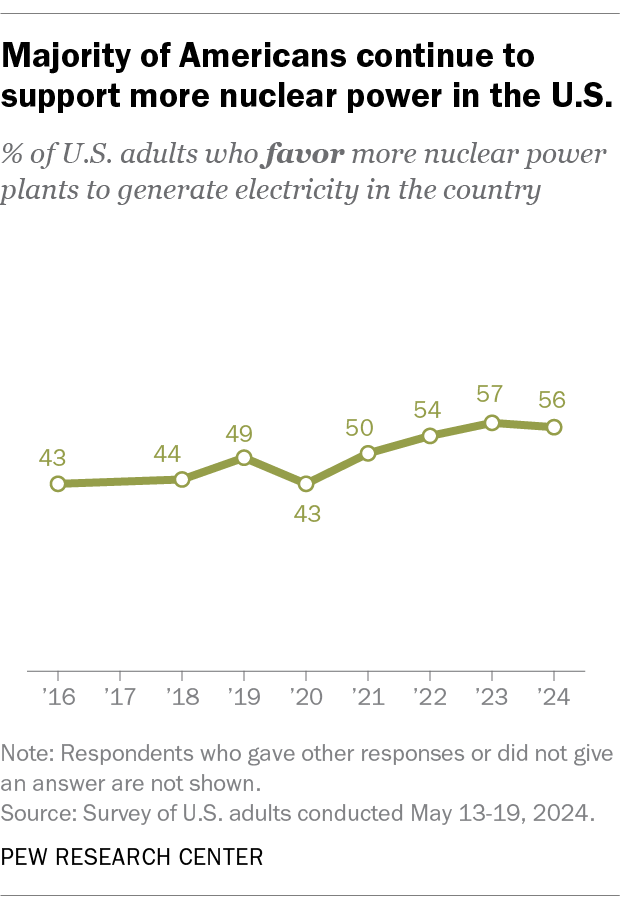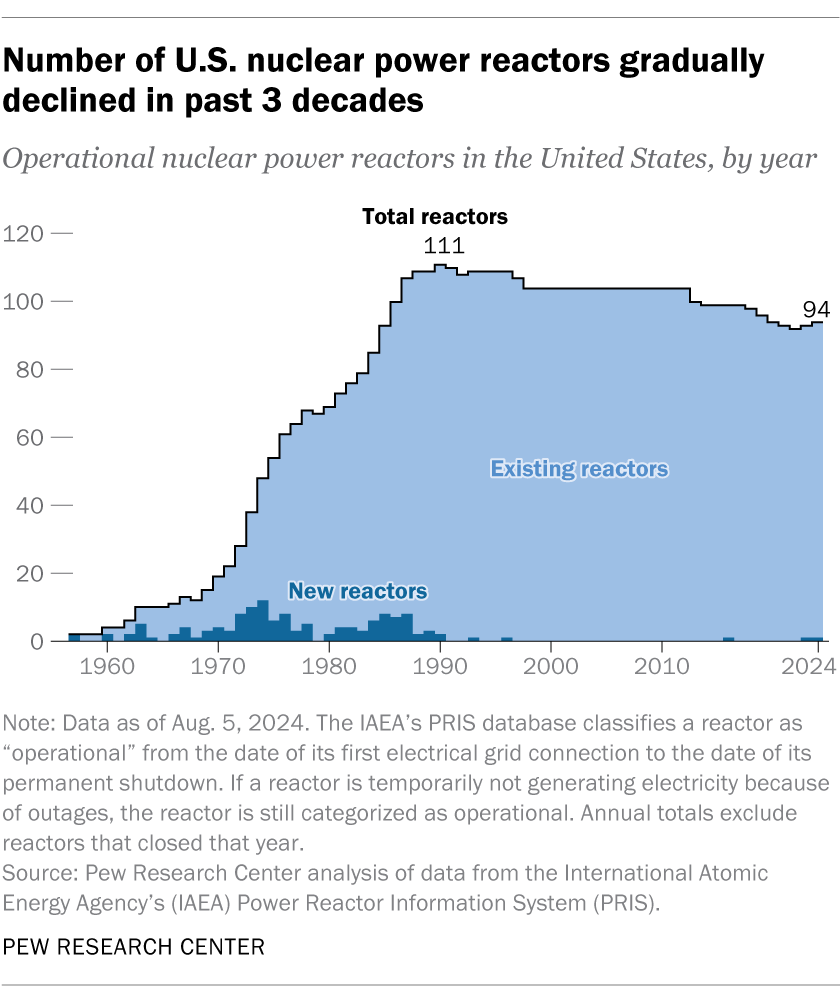Key Takeaways
As concerns grow in the United States about adequate supplies of electricity, public support for nuclear power has grown.
The United States is shuttering plants at 3 times the rate it is building new ones, owing to the regulatory environment as well as the electrical market which has been distorted by enormous subsidies and mandates available to wind and solar power.
China is building new nuclear plants at a stunning pace, with 10 reactors green-lighted in each of the last 2 years and 26 under construction.
Its fleet may soon displace France as number 2 in reactors behind the United States.
Reactors, which run at 90+ percent of their capacity, offer a carbon-free alternative to intermittent energy from wind and solar, which produce at around one-third of nuclear power’s rate.
A majority of U.S. adults remain supportive of expanding nuclear power in the United States, according to a Pew Research Center survey from May. Overall, 56 percent are in favor of more nuclear power plants to generate electricity. Pew also reports that “Americans in both parties now see nuclear power more positively” with support among Democrats up 12 points since 2020 to 49 percent, and up 14 points with Republicans during the same period. While Americans are more supportive, the future of large-scale nuclear power in the United States is uncertain. Despite Congress recently passing legislation intended to ease the nuclear energy industry’s financial and regulatory challenges, reactor shutdowns continue to outpace new construction as the incentives of the Inflation reduction Act and the regulatory environment of the Biden-Harris administration favor wind and solar power that operate at a mere third of nuclear power’s capacity factor. More Americans favor expanding solar power (78 percent) and wind power (72 percent) than nuclear power, but support for solar and wind power has declined by double digits since 2020, while support for nuclear power has grown by 13 percentage points over that time span.

Nuclear Power in the United States
The United States currently has 94 nuclear power reactors, at 53 different power plants located in 28 states. That number includes a reactor that just began operating in Georgia this spring. Georgia Power’s Vogtle Unit 4, which entered commercial operation in April, and Vogtle Unit 3, which entered commercial operation on July 31, 2023, will provide reliable electricity for at least 60 to 80 years. Nuclear power generated 18.6 percent of U.S. electricity in 2023, according to the Energy Information Administration. About half of the United States’ nuclear power reactors (48) are in the South, while nearly a quarter (22) are in the Midwest. There are 18 reactors in the Northeast and six in the West, according to data from the International Atomic Energy Agency (IAEA).
The number of U.S. reactors has steadily fallen since peaking at 111 in 1990. Nine Mile Point-1, located in Scriba, New York, is the oldest U.S. nuclear power reactor still in operation. It first connected to the power grid in November 1969. Most of the 94 current reactors began operations in the 1970s (41) or 1980s (44), according to IAEA data. (The IAEA classifies reactors as “operational” from their first electrical grid connection to their date of permanent shutdown.) Within the last decade, just three new reactors joined the U.S. power fleet. Three times as many were shuttered over the same time span.

Like coal and natural gas plants, nuclear reactors have a hard time competing with the incentives given to wind and solar power. Wind’s production tax credit can make the cost of operating wind power negative, while nuclear, coal and natural gas have positive operating costs. When coal, natural gas and nuclear plants are not operating at full capacity, they have fewer hours of operation over which to spread their costs, often making them uneconomic. The regulatory environment in the United States is also not very conducive to nuclear power in either extending the lives of reactors or approving new plants. Reasons some Americans are negative to nuclear power include perceived dangers following nuclear accidents in the United States and abroad, particularly the accident in Japan; their high construction costs; and radioactive waste storage issues. Anti-nuclear activist groups in the United States and around the world contribute to public unease.
Many advocates in the United States believe that nuclear power is key to reducing emissions from electricity generation. The electricity demands of artificial intelligence demand centers that need reliable and affordable electricity 24/7 have brought about recent interest in reviving decommissioned nuclear power sites, including the Three Mile Island plant and the Palisades plant in Michigan, the latter of which shuttered in 2022. NextEra Energy also is looking at a possible restart of the Duane Arnold plant in Iowa that was closed in 2020. Last year, California announced it would delay the retirement of its Diablo Canyon nuclear power plant until 2030. This summer, construction began on a new plant in Wyoming that will house an advanced sodium-cooled fast reactor, pending approval from the Nuclear Regulatory Commission.
China Continues to Build Nuclear Reactors
In contrast, China leads the world with 26 nuclear reactors under construction, including Unit 5 of the Ningde Nuclear Power Plant in Fujian Province, where the first concrete was poured on July 28. The Ningde Nuclear Power Plant’s second phase for units 5 and 6 will use China’s third-generation nuclear technology, known for its high safety, cost-effectiveness and longevity. China has 55 nuclear reactors in operation, ranking third globally behind the United States with 94 reactors and France with 56 reactors at 18 different power plants. France could build as many as 14 new reactors over the next several years to help meet climate targets. Commercial operation of the long-delayed Unit 3 at Flamanville could be imminent as fuel loading was completed in late May.
China General Nuclear (CGN) is building the two new units at Ningde–a plant that currently is home to four 1,018-megawatt CPR-1000 reactors that entered commercial operation between April 2013 and July 2016. Units 5 and 6 at Ningde, which were approved by the Chinese government on July 31, 2023, will be Hualong One reactors, each with more than 1 gigawatt of capacity. First concrete also was poured recently for Unit 1 of the Shidaowan nuclear plant in Shandong Province, which will feature another Hualong One reactor. The Shidaowan facility is being built by China Huaneng.
The Shidaowan site is known for being home to the High Temperature Gas-Cooled Reactor-Pebble-bed Module, or HTR-PM, demonstration project that has been online since December 2023. That project has two small reactors powering one 210-megawatt turbine. The project is owned by a consortium of China Huaneng, China Nuclear Engineering Corp. (a subsidiary of China National Nuclear Corp.), and Tsinghua University’s Institute of Nuclear and New Energy Technology. Shidaowan uses both the latest independent third-generation nuclear power technology and fourth-generation advanced nuclear power technology. The plan for Shidaowan includes four, 1.2-gigawatt Hualong One reactors, with the first two expected online in 2029.
Conclusion
Support for nuclear power is growing in the United States, but existing reactors are still being shuttered faster than new ones are built. In contrast, China is rapidly expanding its nuclear reactor fleet. The country in both 2022 and 2023 approved construction of 10 new reactors, and Chinese officials have touted their strategy of standardized development of nuclear power plants, enabling faster completion of projects. Electricity demand growth from AI data centers in the United States and the Biden-Harris energy transition to electrify everything may spur the industry to grow, but the massive incentives for wind and solar power, high nuclear construction costs and the hostile environment of the Nuclear Regulatory Commission may stand in the way, despite the new legislation signed by President Biden.



